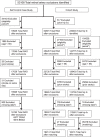The association of stroke with central and branch retinal arterial occlusion
- PMID: 33911211
- PMCID: PMC8956663
- DOI: 10.1038/s41433-021-01546-6
The association of stroke with central and branch retinal arterial occlusion
Abstract
Objectives: To determine the near-term risk of stroke following a retinal artery occlusion (RAO).
Methods: The risk of stroke was assessed in two manners; with a self-controlled case series (SCCS) and a propensity score (PS) matched cohort study using a US medical claims database. The date of RAO diagnosis was assigned as the index date. In the SCCS, incidence of stroke was compared in 30- and 7-day periods pre- and post-index date. In PS analysis, matched cohorts were created from patients with RAO or hip fracture. Cox proportional hazard regression assessed the hazard for stroke. Patients were censored at 1 year, upon leaving the insurance plan or if they had a qualifying event for the comparison group.
Results: The SCCS included 16,193 patients with RAO. The incidence rate ratio (IRR) of new stroke in the month after RAO was increased compared to all periods >2 months before and all months after the index date (IRRs: 1.68-6.40, p < 0.012). Risk was increased in the week immediately following the index date compared to most weeks starting 2 weeks prior to and all weeks immediately after the index date (IRRs: 1.93-29.00, p < 0.026). The PS study analysed 18,213 propensity-matched patients with RAO vs. hip fracture. The HR for having a stroke after RAO compared to a hip fracture was elevated in all analyses (All RAO HR: 2.97, 95% CI: 2.71-3.26, p < 0.001; CRAO HR: 3.24, 95% CI: 2.83-3.70, p < 0.001; BRAO HR: 2.76, 95% CI: 2.43-3.13, p < 0.001).
Conclusions: The highest risk for stroke occurs in the days following a CRAO or BRAO, supporting guidelines suggesting immediate referral to a stroke centre upon diagnosis.
© 2021. The Author(s), under exclusive licence to The Royal College of Ophthalmologists.
Conflict of interest statement
The authors declare no competing interests.
Figures



Similar articles
-
Central and Branch Retinal Artery Occlusion-Do They Harbor the Same Risk of Further Ischemic Events?J Clin Med. 2021 Jul 13;10(14):3093. doi: 10.3390/jcm10143093. J Clin Med. 2021. PMID: 34300257 Free PMC article.
-
Risk of Retinal Artery Occlusion in Patients with Migraine.Am J Ophthalmol. 2021 May;225:157-165. doi: 10.1016/j.ajo.2020.11.004. Epub 2020 Dec 24. Am J Ophthalmol. 2021. PMID: 33359716
-
Retinal artery occlusion and the 3-year risk of stroke in Taiwan: a nationwide population-based study.Am J Ophthalmol. 2012 Oct;154(4):645-652.e1. doi: 10.1016/j.ajo.2012.03.046. Epub 2012 Jul 17. Am J Ophthalmol. 2012. PMID: 22809785
-
Risk of acute stroke in patients with retinal artery occlusion: a systematic review and meta-analysis.Eye (Lond). 2020 Apr;34(4):683-689. doi: 10.1038/s41433-019-0576-y. Epub 2019 Sep 16. Eye (Lond). 2020. PMID: 31527762 Free PMC article.
-
Risk of acute stroke in patients with retinal artery occlusion: a systematic review and meta-analysis.Eur Rev Med Pharmacol Sci. 2023 Jun;27(12):5627-5635. doi: 10.26355/eurrev_202306_32803. Eur Rev Med Pharmacol Sci. 2023. PMID: 37401301
Cited by
-
Atrial fibrillation in Retinal Artery Occlusions.Cardiol Cardiovasc Med. 2025;9(4):234-247. Epub 2025 Jul 7. Cardiol Cardiovasc Med. 2025. PMID: 40761687 Free PMC article.
-
Retina-Brain Homology: The Correlation Between Ophthalmic or Retinal Artery Occlusion and Ischemic Stroke.Eye Brain. 2024 Aug 12;16:25-38. doi: 10.2147/EB.S454977. eCollection 2024. Eye Brain. 2024. PMID: 39156910 Free PMC article. Review.
-
Retinal Artery Occlusion and Its Impact on the Incidence of Stroke, Myocardial Infarction, and All-Cause Mortality during 12-Year Follow-Up.J Clin Med. 2022 Jul 14;11(14):4076. doi: 10.3390/jcm11144076. J Clin Med. 2022. PMID: 35887842 Free PMC article.
-
Risk Factors and Treatment Strategy for Retinal Vascular Occlusive Diseases.J Clin Med. 2022 Oct 27;11(21):6340. doi: 10.3390/jcm11216340. J Clin Med. 2022. PMID: 36362567 Free PMC article. Review.
-
Redefining the Koizumi model of mouse cerebral ischemia: A comparative longitudinal study of cerebral and retinal ischemia in the Koizumi and Longa middle cerebral artery occlusion models.J Cereb Blood Flow Metab. 2022 Nov;42(11):2080-2094. doi: 10.1177/0271678X221109873. Epub 2022 Jun 24. J Cereb Blood Flow Metab. 2022. PMID: 35748043 Free PMC article.
References
MeSH terms
Grants and funding
LinkOut - more resources
Full Text Sources
Other Literature Sources
Medical

